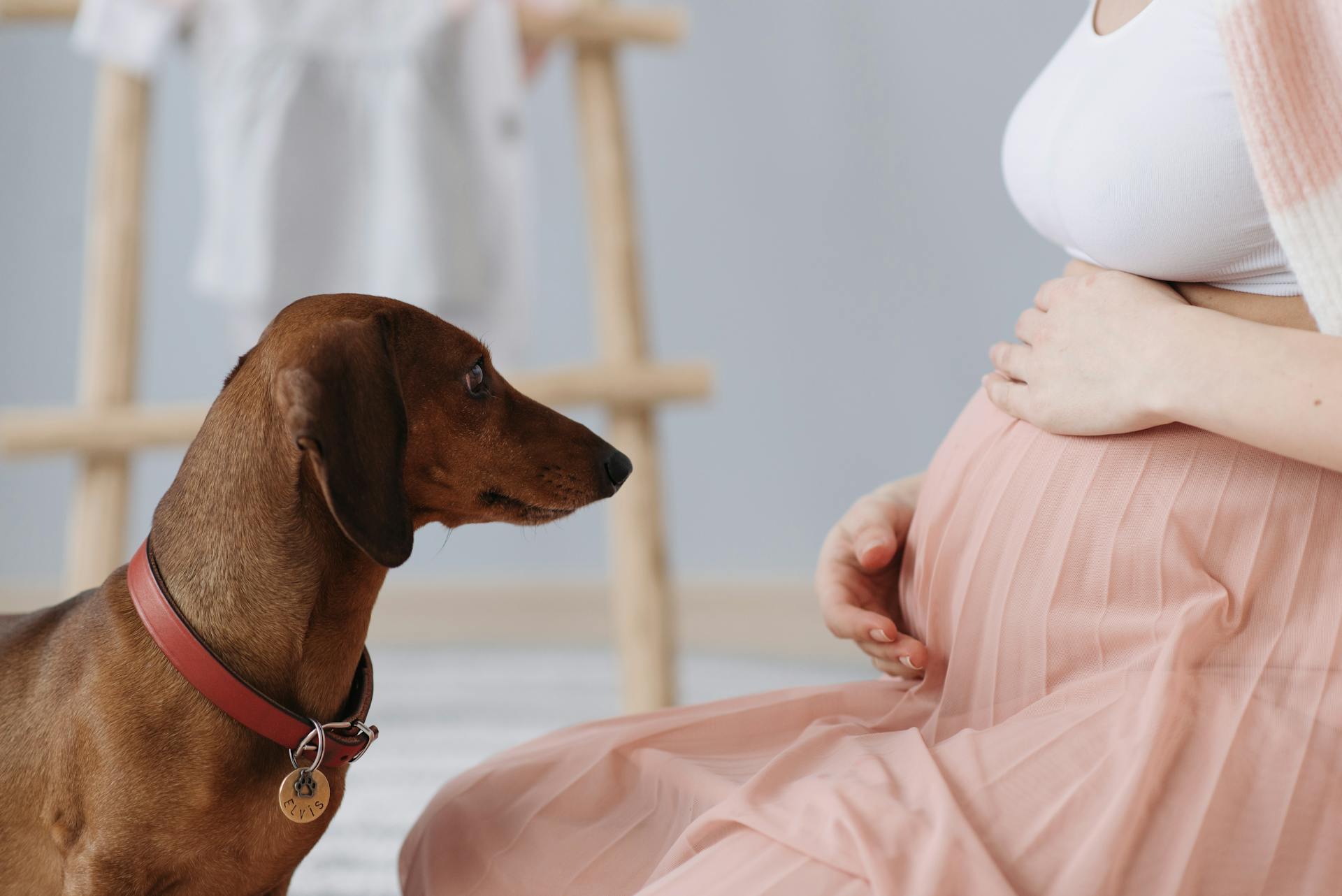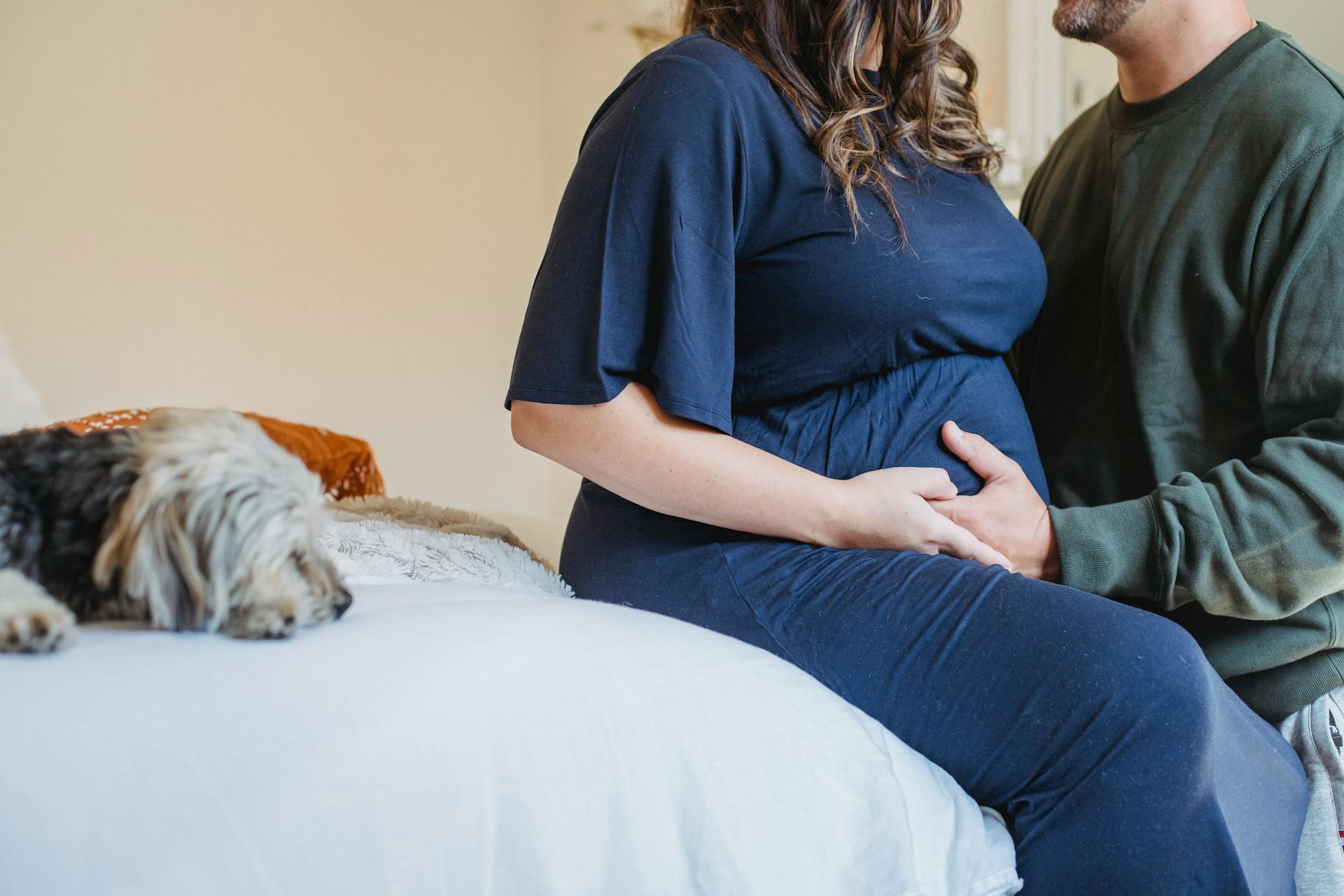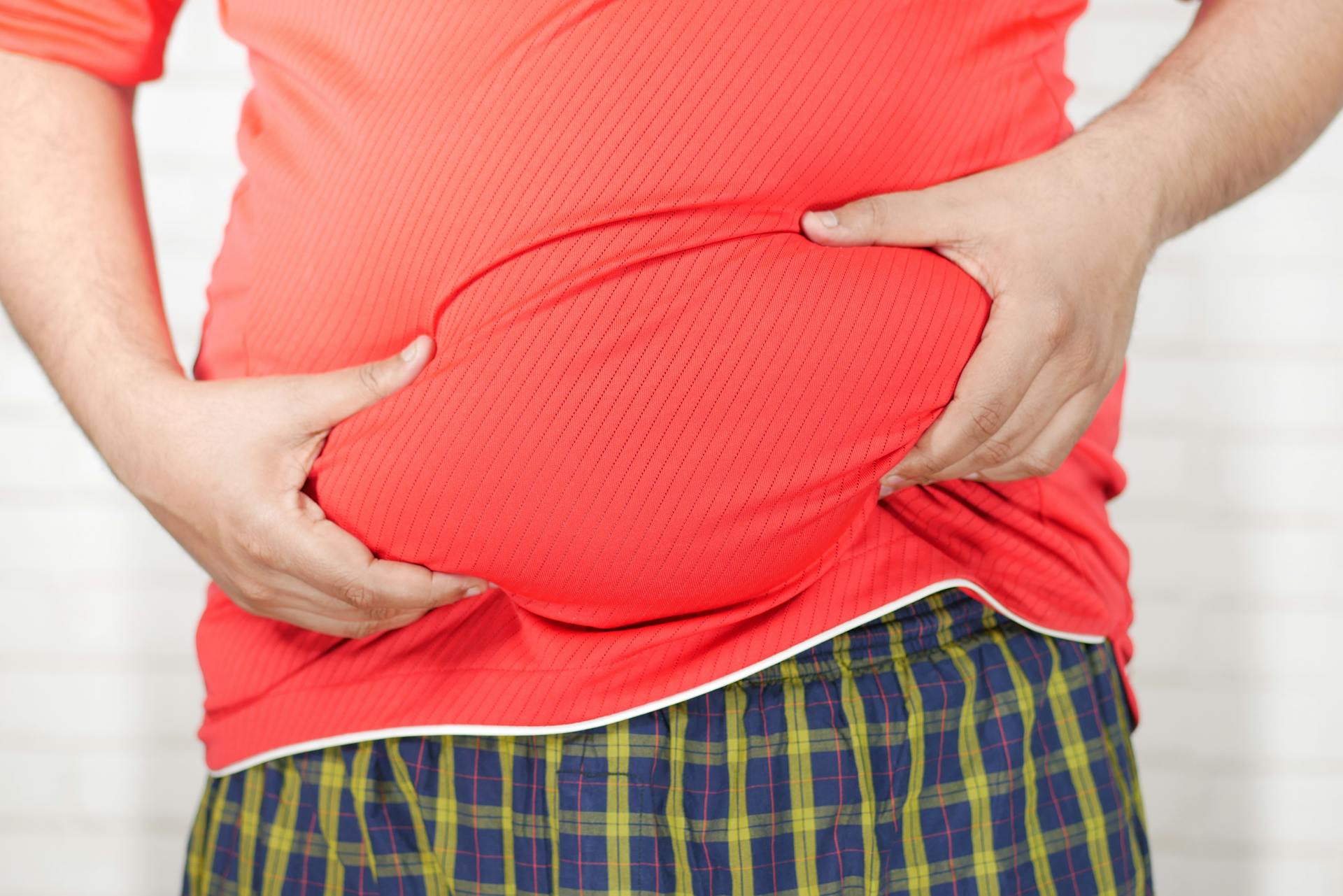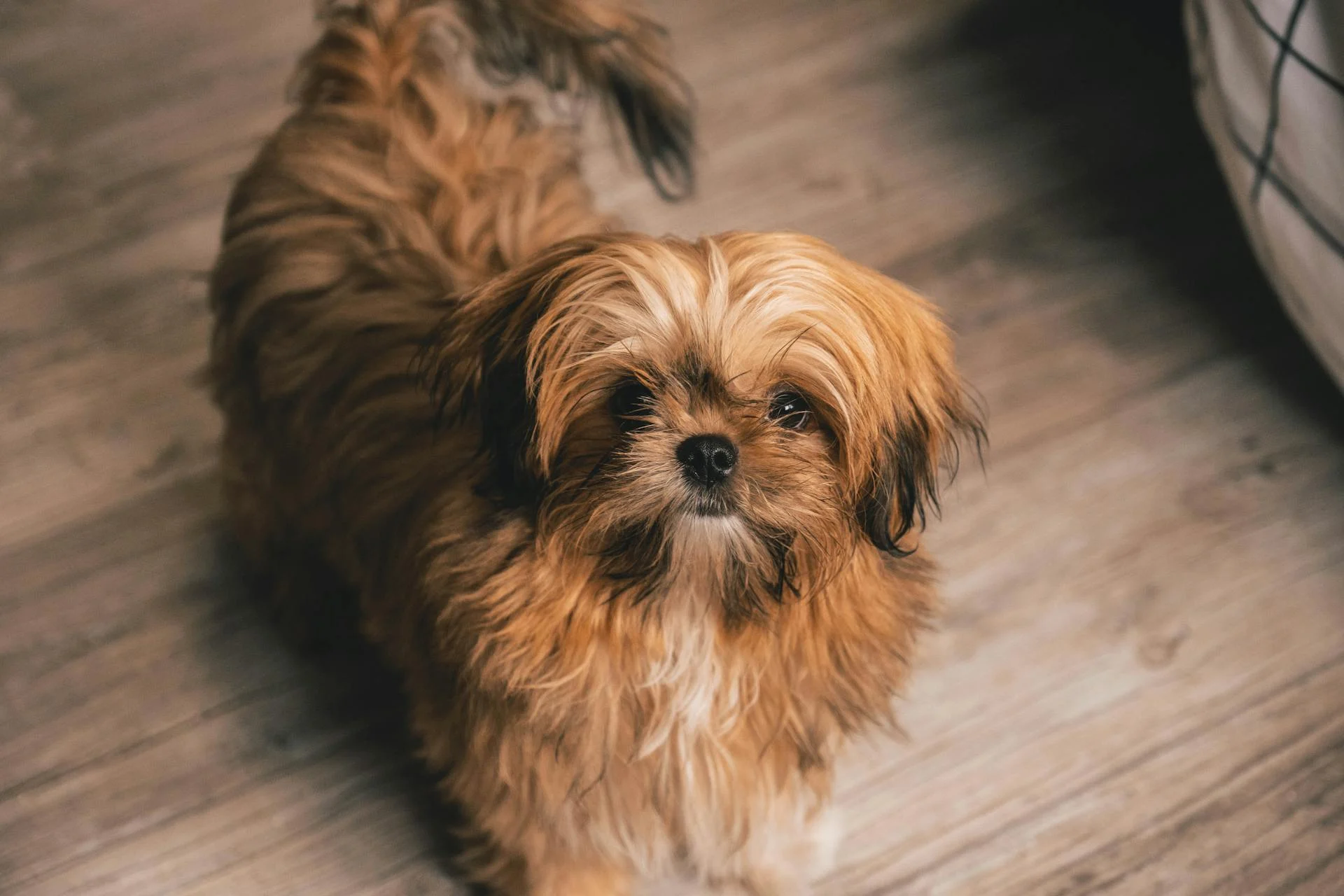
Dog belly button lumps can be a worrisome sight for any dog owner. A lump near the navel, also known as an umbilical hernia, is a common issue in dogs.
There are two main types of lumps that can appear near a dog's belly button: congenital and acquired. Congenital lumps are present at birth, while acquired lumps develop later in life.
Some lumps may be benign, while others can be a sign of an underlying health issue. A dog's age, size, and breed can all play a role in the likelihood of developing a belly button lump.
Treatment options for dog belly button lumps vary depending on the type and severity of the lump.
You might enjoy: Female Dog Belly Button
Causes and Types
Umbilical hernias in dogs are relatively common and often occur in certain family lines, meaning a dog's genetics can play a role in whether they develop one.
Genetics can determine if a dog will get an umbilical hernia, and some experts think multiple genes may be involved, many of which are passed on in a recessive manner.
Dogs who don't have an umbilical hernia themselves may still pass the trait on to some of their puppies.
Here are some key points to consider:
- Dogs who don't have an umbilical hernia may still pass the trait on to some of their puppies.
- Two dogs with the trait shouldn't be bred to each other because all of the puppies could have umbilical hernias.
Trauma can also lead to an umbilical hernia, such as if the puppy's umbilical cord is removed too aggressively, creating an opening in the body wall that leaves behind a hole when it heals.
Common Lumps
Common lumps on dogs can be a source of worry, but most are benign and easily identifiable by a vet. Your vet can often tell what a lump is just by looking at it.
Some lumps, like histiocytomas or button tumors, are red, bubble-shaped, and non-cancerous. They typically appear on young dogs and puppies between 8 weeks and 3 years old.
Histiocytomas are a buildup of excess immune cells that press into the skin and are usually able to go away on their own. However, if your pup starts to get irritated by it, it may be better to discuss a surgical removal with your vet.
Readers also liked: Vets Dog Treats
If you notice a lump near your dog's belly button, it could be an umbilical hernia. These hernias are usually found on the midline of a dog's belly, just below the rib cage.
Umbilical hernias can be small or large, and some may be reducible, meaning a vet can push the fat or other abdominal contents back into the abdominal cavity. However, others may be non-reducible, making it impossible to push everything back in.
Here's a quick guide to some common lumps on dogs:
Keep in mind that most lumps are benign, and a biopsy or surgery isn't always needed. If you're unsure about a lump, it's always best to consult with your vet for a proper diagnosis and treatment plan.
Causes of Umbilical Hernia
Umbilical hernias in dogs are relatively common and often occur in certain family lines, meaning a dog's genetics play a significant role in determining whether they'll develop one.

Genetics are thought to be involved, with several genes passed on in a recessive manner, which means dogs who don't have an umbilical hernia themselves can still pass the trait on to some of their puppies.
Reputable breeders will not breed a dog with a very large umbilical hernia and will avoid breeding two dogs with umbilical hernias together, even if the hernias are small.
Trauma can also lead to an umbilical hernia, such as if a puppy's umbilical cord is removed too aggressively, creating an opening in the body wall that leaves behind a hole when it heals.
The American Kennel Club doesn't have strict recommendations against breeding dogs with small umbilical hernias, but breeders should still prioritize the health and well-being of their dogs.
Here are some key genetic implications to consider:
- Dogs who don’t have an umbilical hernia themselves may still pass the trait on to some of their puppies.
- Two dogs with the trait shouldn’t be bred to each other because all of the puppies could have umbilical hernias.
It's essential to be aware of these genetic factors when considering breeding or adopting a dog with an umbilical hernia.
Malignant Bumps and Tumors in Dogs
Malignant Bumps and Tumors in Dogs are a serious concern, and it's crucial to get any unusual growths checked out by a veterinarian as soon as possible.
Some bumps, lumps, and growths on dogs can be cancerous, and it's essential to rule out cancer to ensure your pup receives proper treatment.
Many bumps, lumps, and growths are non-cancerous, but it's still necessary to have them checked out by a vet to be on the safe side.
If a bump or lump is diagnosed as cancerous, your veterinarian will recommend a treatment plan tailored to your pup's specific needs.
Some examples of malignant bumps, lumps, and growths on dogs include growths that need to be checked out by a vet as soon as possible.
Diagnosis and Signs
A dog's umbilical hernia can be identified by its location on the midline of the belly, just below the rib cage.
You can spot a small umbilical hernia as a little soft lump about 1/2 of an inch wide.
Broaden your view: Shih Tzu Hernia
Large umbilical hernias can be identified by the presence of abdominal organs like loops of intestines that have moved through the hernia.
Some hernias are reducible, meaning a veterinarian can push the fat or other abdominal contents back into the dog's abdomen.
However, non-reducible hernias will have fat or abdominal organs stuck in the opening of the body wall, with scar material forming to make it impossible to push everything back in.
To determine if your dog has a reducible or non-reducible hernia, consult with a veterinarian for a proper evaluation.
Safety and Treatment
Most umbilical hernias in dogs are a cosmetic issue and don't pose a significant threat to their health. However, there are two potential risks to be aware of: strangulation and trauma to the skin.
Strangulation is a medical emergency that occurs when the abdominal contents twist or become pinched, cutting off their blood supply. This is a rare occurrence, but it's essential to monitor your dog's hernia closely.
Large umbilical hernias should be repaired to prevent strangulation and to avoid the risk of trauma to the skin. If your dog has a small hernia, it may close on its own by the time they're 3 to 4 months old.
If your veterinarian recommends surgery to repair the hernia, it's usually done in conjunction with other procedures, such as spaying or neutering. The surgery involves pushing the herniated tissues back into the abdominal cavity and closing the opening with sutures or mesh.
After surgery, it's crucial to prevent your dog from licking or chewing at the incision site, as this can lead to complications. Your veterinarian may recommend using an E-collar, bandages, or a surgery recovery suit to protect the area.
Here are some general guidelines for umbilical hernia treatment:
Frequently Asked Questions
Do umbilical hernias go away in dogs?
Umbilical hernias in dogs often resolve on their own as the body heals, but in some cases, surgical intervention may be necessary to ensure the condition doesn't worsen. Consult a veterinarian for proper evaluation and guidance on your puppy's specific situation.
Sources
- https://www.walkervillevet.com.au/blog/help-dog-lump/
- https://www.imprimedicine.com/blog/lumps-on-dogs
- https://lincolnwayvet.com/blog/lumpy-mass-growth-dog/
- https://www.diamondpet.com/blog/health/sensitive-skin/the-12-lumps-and-bumps-of-canine-skin/
- https://be.chewy.com/umbilical-hernias-in-dogs-more-common-than-you-think/
Featured Images: pexels.com

